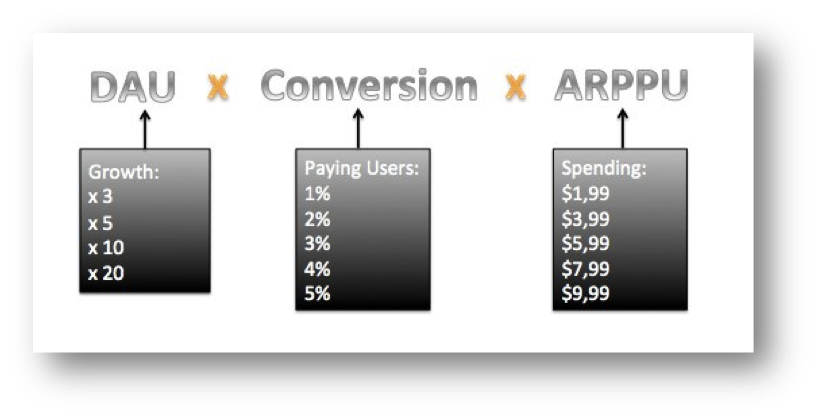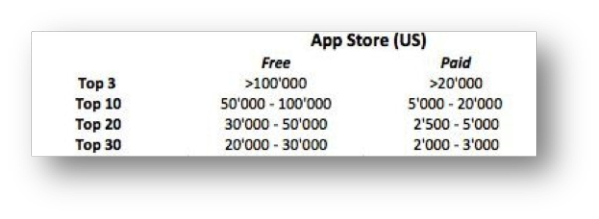· 9 min read
From Paid to Free(mium) in Three Steps
Michail Katkoff
Product Manager at Supercell
1. Make the Business Case

Daily Active Users
The whole idea behind cutting away the price of the app is to significantly increase the amount of installs. The increase in installs your app will be getting depends on several variables, such as the current rank in the app store, current price, marketing, promotion, and potential cross promotion.

Based on these variables, transitioning to freemium could have a huge impact on your growth. To try this out, you can list your app on a “free app a day” site to see what the combination of promotion and price does to your download rate.
Also, you should monitor the daily active users to total users ratio. This will give you an idea of how engaging your game is, and of how many of your users will be likely to spend money on a freemium game. This leads to our next variable, Conversion.
Conversion
Average Revenue Per Paying User (ARPPU)
The final variable of the formula is the ARPPU, which is tied to the in-app purchase offerings of your app. To maximize ARPPU, you should always try to offer high-value, high-price bundles. According to my experience, the demand tends to be quite price-inflexible when it comes to high purchase points.
Also, favor consumable items instead of permanent items both in your game and in your promotions. These are more valuable to engaged players because they will use the items during gameplay, and their consumable nature increases re-purchases.
2. Create Demand
Restrictions
- First, don’t confuse restrictions with pay walls. By this I mean that players should be able to progress without paying, and restrictions are there only to slow this progress. You are selling a shortcut, not the gameplay itself. This will prevent players from being frustrated.
- Secondly, start with light restrictions, and then increase them slowly and steadily. This way, you won’t scare away players in the beginning, and once players are engaged they will either convert to paying or wait out even the toughest restrictions.
- Lastly, always offer at least two purchase options to bypass the restriction. An example of this would be a smaller amount of paid currency and a significant amount of free currency, while the other option would be a larger amount of paid currency. The intention is to make the small price point offer look extremely unattractive and thus incentivize players to make the reasonable purchase with the higher price point.
To restrict the progression, you have added a timer mechanic so that every time players complete a level pack they have to wait for a specific time until they can continue the adventure. Players can skip the waiting period by either purchasing a single unlock, which unlocks the next level pack (10 levels), or by unlocking all the level packs (100 levels) with a slightly larger purchase. The waiting period grows after each completed level pack, making the all levels unlock purchase more and more attractive.
Achievements
For example:
To enter the locked level, a player must get a first place finish in all five previous levels. Players can improve the chances of winning a race by purchasing consumable boosters with in-app purchases, or they can purchase the ability to open the chest outright.
3. Track and Adjust
Now you have a business case, which gives you goals to shoot for in order to make your game a freemium success. You’ve created offers with built-in demand to encourage in-app purchases.
Now, in order to successfully make the switch from paid to freemium, you need to implement the tracking of your key metrics. Once the app transitions from paid to free in the app stores, the development and marketing teams should be looking to optimize the game based on the data they get.
Be sure to keep the above Restrictions and Achievements in mind when setting up your tracking. Tracking and analyzing the data is essential, both for improving your monetization and engagement and to know how you are doing with regard to the business case you’ve made.
Once you know where you stand, it’s much easier to prioritize following updates and achieve the business goals you have set.
Suppose now that your went freemium and you’ve got disappointing numbers. How do you adjust to the situation? Let me give you some suggestions below:
- DAU: going from paid to free should be accompanied with a marketing and PR campaign. Have you game featured on FreeAppADay and various blogs and tweets to ensure exposure. If you have other titles, go hard on cross-promotion. If this is your only title, then consider buying cross promotion (Android only). And being in the Featured section of the Google or Apple store is naturally worth striving for…
- ARPPU: low ARPPU usually means that either your prices are too low (counterintuitive, but remember only 1-5% of your players are buying) or that your larger price points fail to offer the perceived higher value. Take a closer look at your data and see at which point in the game users are making purchases and what they are purchasing. Once you know this information, you can rearrange you offering so that it better suits players in those converting phases of the game. At the same time, make sure you unbalance the price points so that the higher prices offer unbeatable value compared to the lower ones. Again, because only 1-5% of your players are buying in most games, you want to give them a lot of incentive to make a larger purchase.
- Conversion: conversion is the toughest variable to improve. When it’s low, it implicates that the demand you’ve created isn’t strong enough, or that your in-app offering doesn’t answer to the demand. If you suspect that either of those two cases is true, you need to go back to step two and really analyze how players are playing the game.
However, be sure that you’re not missing the low-hanging fruit in your design and user experience. I’ve seen games where purchasable content is simply too well hidden to be noticed because designers are afraid it might scare players.
Don’t be afraid! While you don’t want to be obnoxious about it, most players are now used to freemium games and are not fazed by prompts to buy in-app purchases. From your data, see what percentage of DAUs is seeing the purchase wall. If it’s below 20%, you need make better use of various screens in the game, such as Level Failed, Level Selector and Welcome Screen. In particular, Level Failed is a great place to sell your in-app purchases because players are looking for ways to improve their play.

In the end, it’s all about understanding the difference between paid and freemium business models and analysing the potential of your paid game succeeding as a freemium.
The key is in creating demand and giving players the possibility to fulfill the demand with in-app purchases.
There is one final thing I want to mention: don’t expect to nail the transformation to freemium instantly. You need track and adjust your game to improve your numbers and revenue. Going from paid to freemium is a tough challenge, but if you execute the transition well, it will certainly pay off. Good luck!